1.树概念及结构
1.1树的概念

注意:树形结构中,子树之间不能有交集,否则就不是树形结构
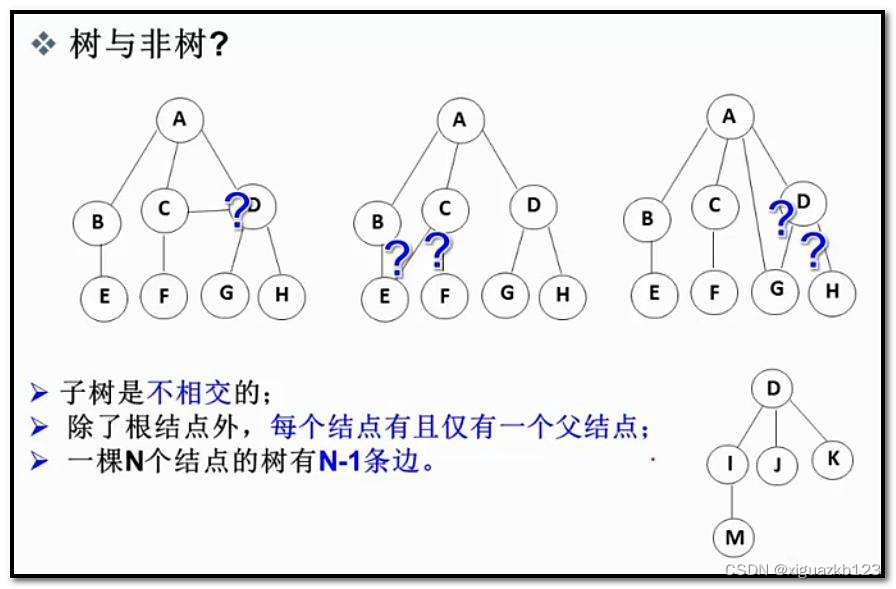
1.2 树的相关概念
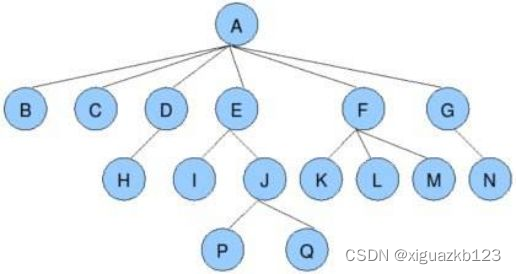
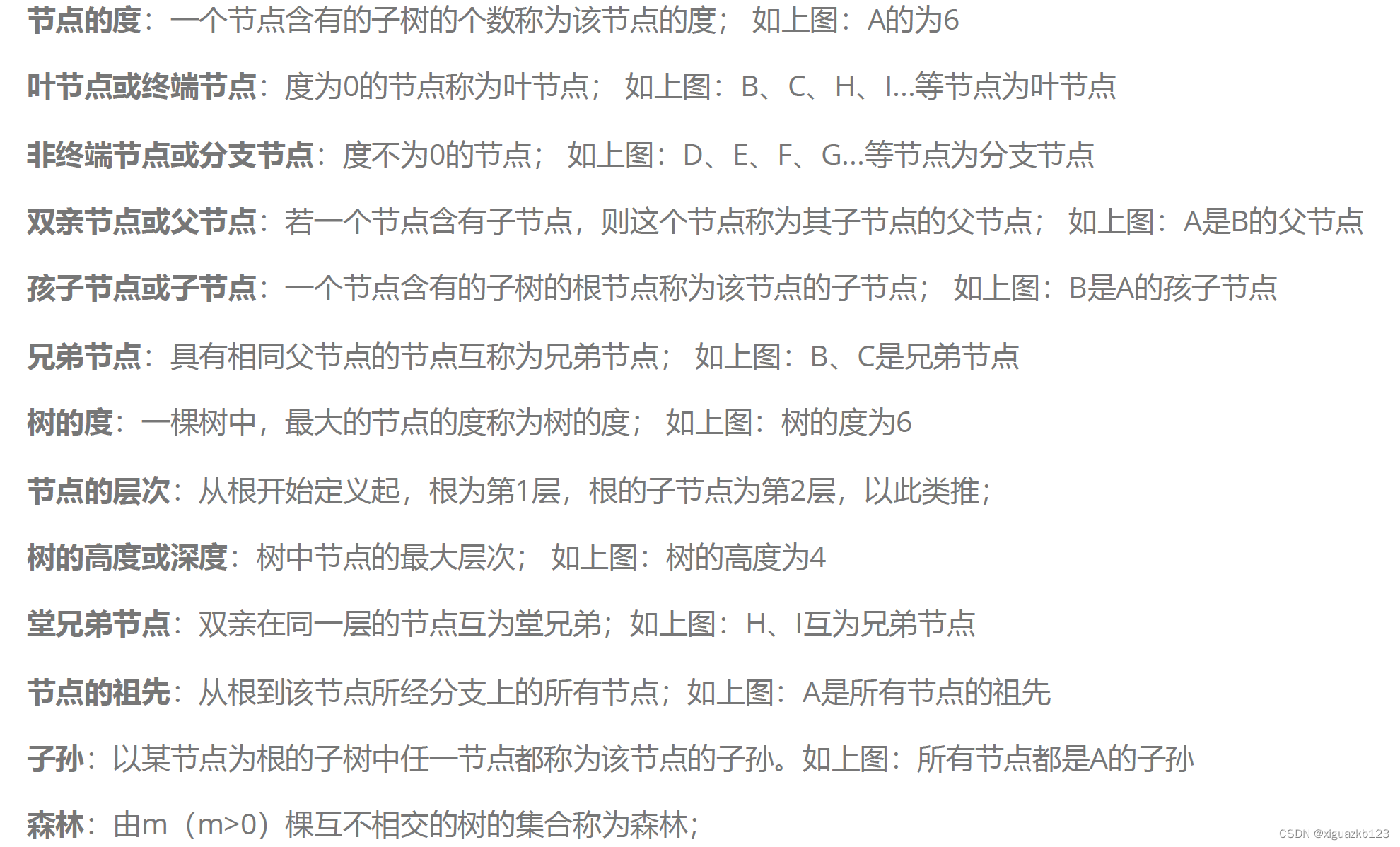 1.3 树的表示
1.3 树的表示
树结构相对线性表就比较复杂了,要存储表示起来就比较麻烦了,既然保存值域,也要保存结点和结点之间的关系,实际中树有很多种表示方式如:双亲表示法,孩子表示法、孩子双亲表示法以及孩子兄弟表示法等。
我们这里就简单的了解其中最常用的孩子兄弟表示法。


1.4 树在实际中的运用(表示文件系统的目录树结构)
2.二叉树概念及结构
2.1概念
一棵二叉树(度最大为2)是结点的一个有限集合,该集合:
- 1. 或者为空
- 2. 由一个根节点加上两棵别称为左子树和右子树的二叉树组成
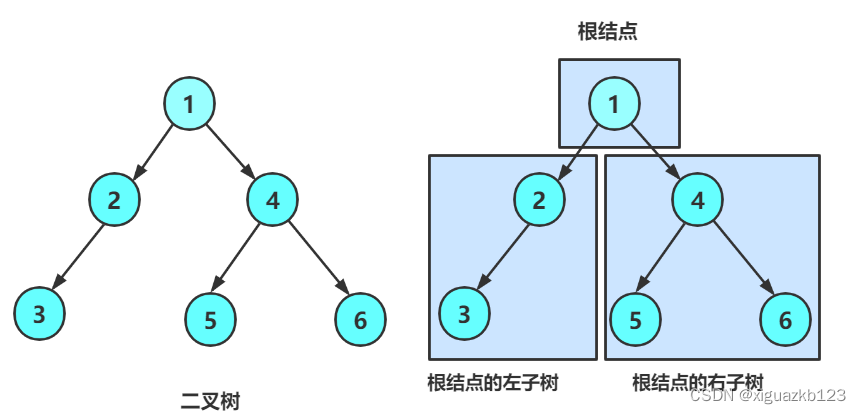
从上图可以看出:
- 1. 二叉树不存在度大于2的结点
- 2. 二叉树的子树有左右之分,次序不能颠倒,因此二叉树是有序树
注意:对于任意的二叉树都是由以下几种情况复合而成的:

2.2现实中的二叉树:

2.3 特殊的二叉树:
1. 满二叉树:一个二叉树,如果每一个层的结点数都达到最大值,则这个二叉树就是满二叉树。也就是说,如果一个二叉树的层数为K,且结点总数是
,则它就是满二叉树。
2. 完全二叉树:完全二叉树是效率很高的数据结构,完全二叉树是由满二叉树而引出来的。对于深度为K的,有n个结点的二叉树,当且仅当其每一个结点都与深度为K的满二叉树中编号从1至n的结点一一对应时称之为完全二叉树。 要注意的是满二叉树是一种特殊的完全二叉树。
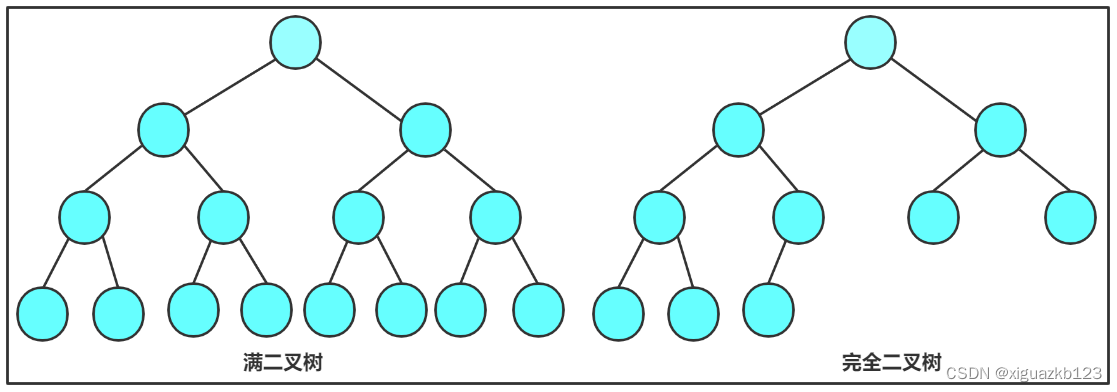

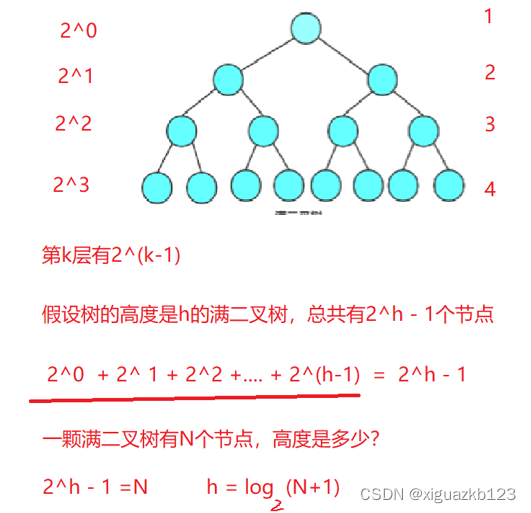
2.4二叉树的性质
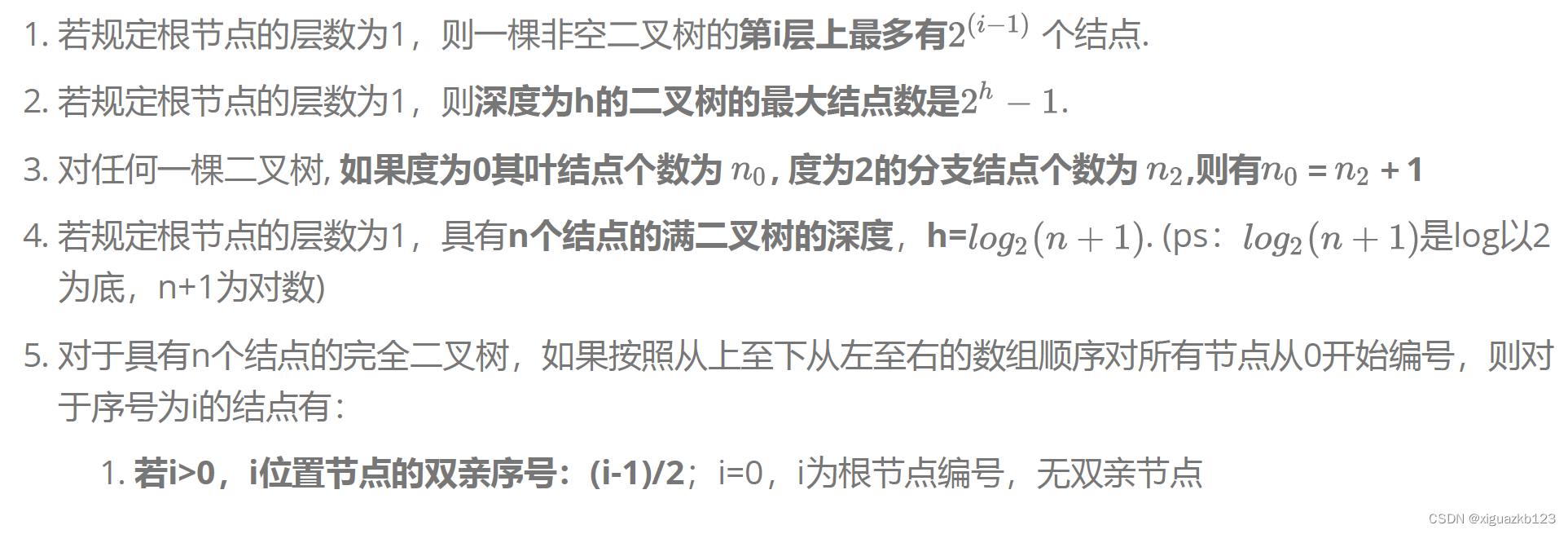

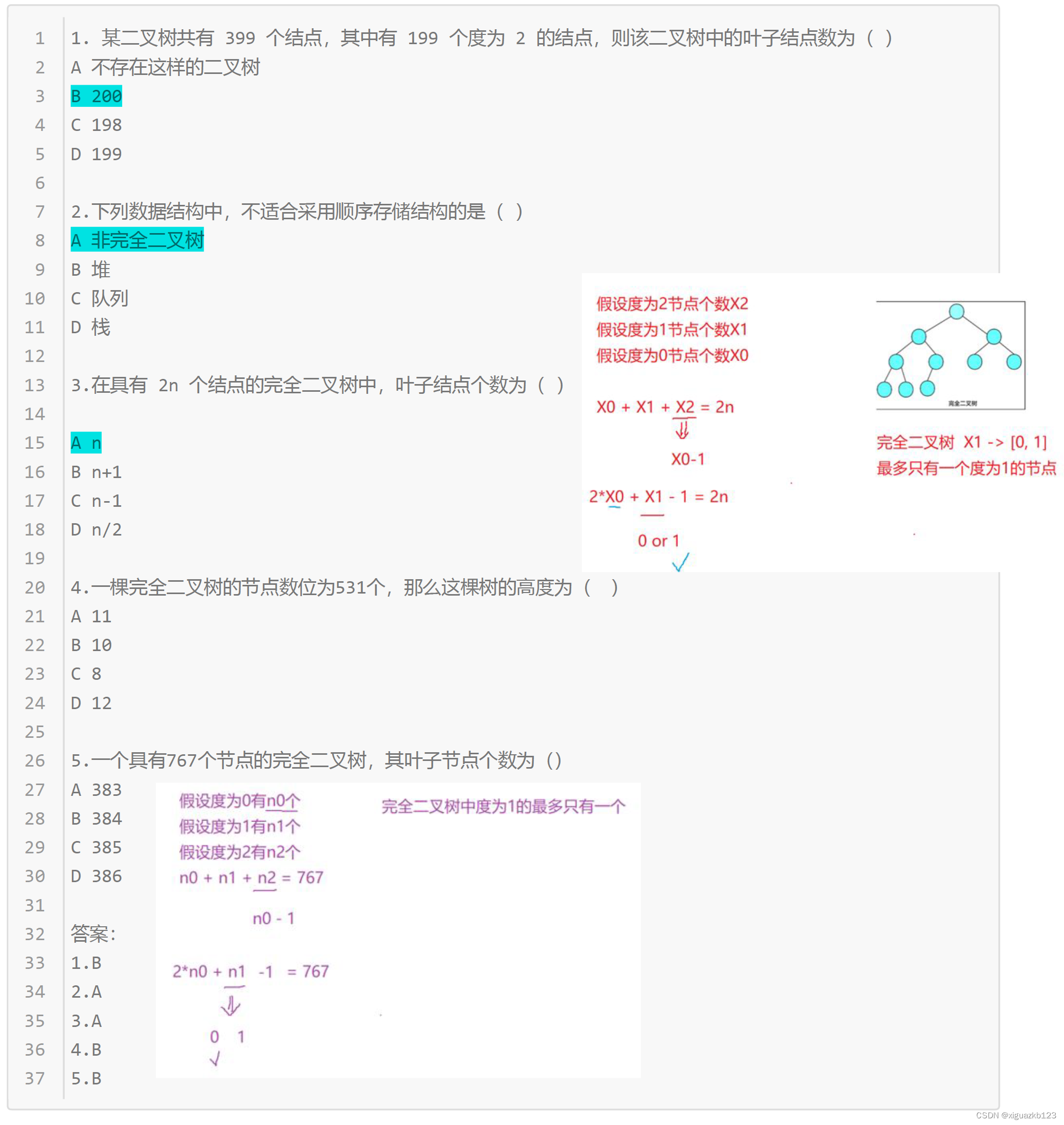
2.5 二叉树的存储结构
二叉树一般可以使用两种结构存储,一种顺序结构,一种链式结构。
1. 顺序存储
顺序结构存储就是使用数组来存储,一般使用数组只适合表示完全二叉树,因为不是完全二叉树会有空间的浪费。而现实中使用中只有堆才会使用数组来存储,关于堆我们后面的章节会专门讲解。二叉树顺序存储在物理上是一个数组,在逻辑上是一颗二叉树。


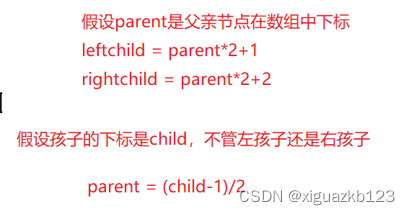
2. 链式存储
二叉树的链式存储结构是指,用链表来表示一棵二叉树,即用链来指示元素的逻辑关系。 通常的方法是链表中每个结点由三个域组成,数据域和左右指针域,左右指针分别用来给出该结点左孩子和右孩子所在的链结点的存储地址 。链式结构又分为二叉链和三叉链,当前我们学习中一般都是二叉链,后面课程学到高阶数据结构如红黑树等会用到三叉链。
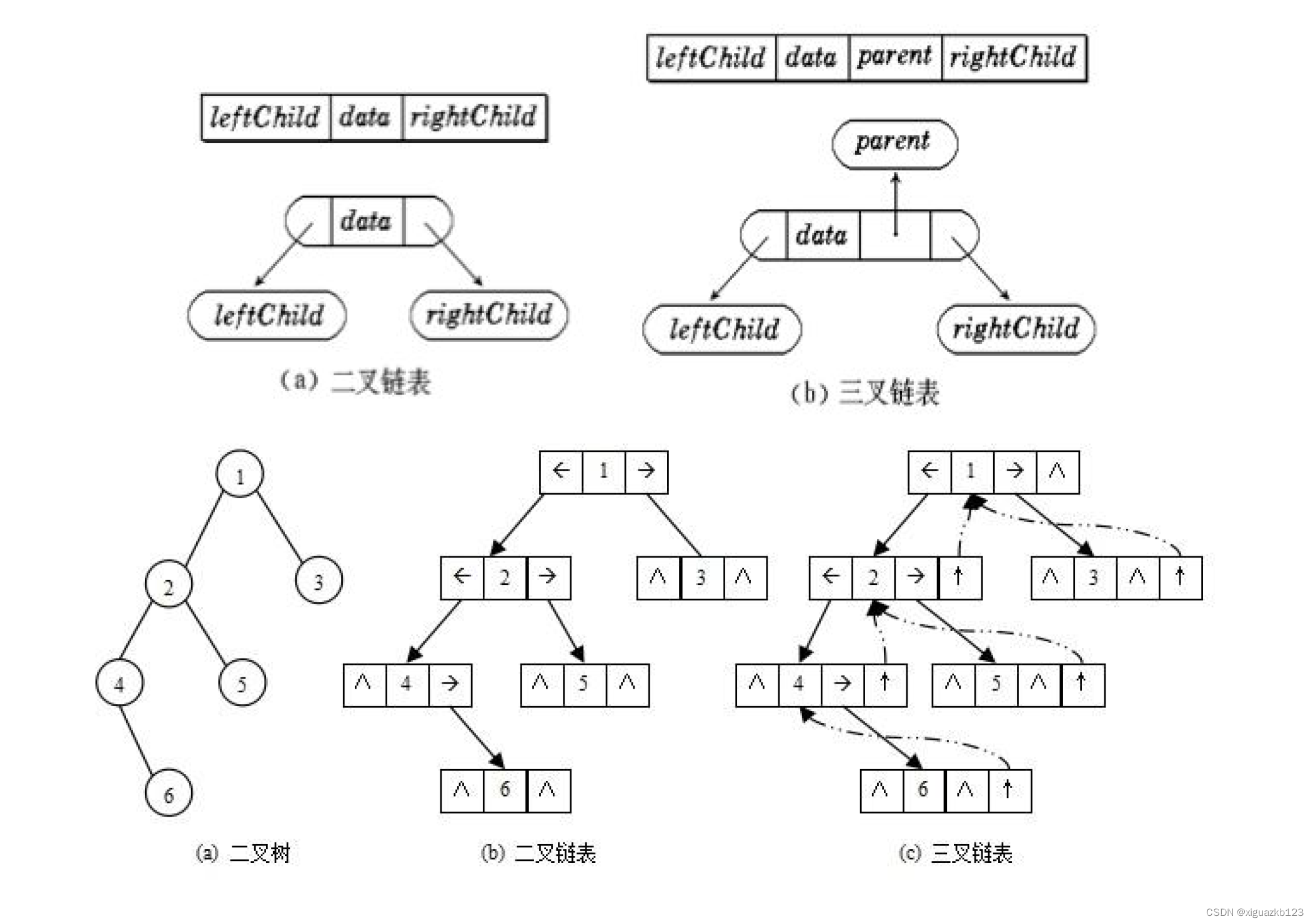
typedef int BTDataType;
// 二叉链
struct BinaryTreeNode
{
struct BinTreeNode* _pLeft; // 指向当前节点左孩子
struct BinTreeNode* _pRight; // 指向当前节点右孩子
BTDataType _data; // 当前节点值域
}
// 三叉链
struct BinaryTreeNode
{
struct BinTreeNode* _pParent; // 指向当前节点的双亲
struct BinTreeNode* _pLeft; // 指向当前节点左孩子
struct BinTreeNode* _pRight; // 指向当前节点右孩子
BTDataType _data; // 当前节点值域
};3.二叉树的顺序结构及实现
3.1 二叉树的顺序结构
普通的二叉树是不适合用数组来存储的,因为可能会存在大量的空间浪费。而完全二叉树更适合使用顺序结构存储。现实中我们通常把堆(一种二叉树)使用顺序结构的数组来存储,需要注意的是这里的堆和操作系统虚拟进程地址空间中的堆是两回事,一个是数据结构,一个是操作系统中管理内存的一块区域分段。
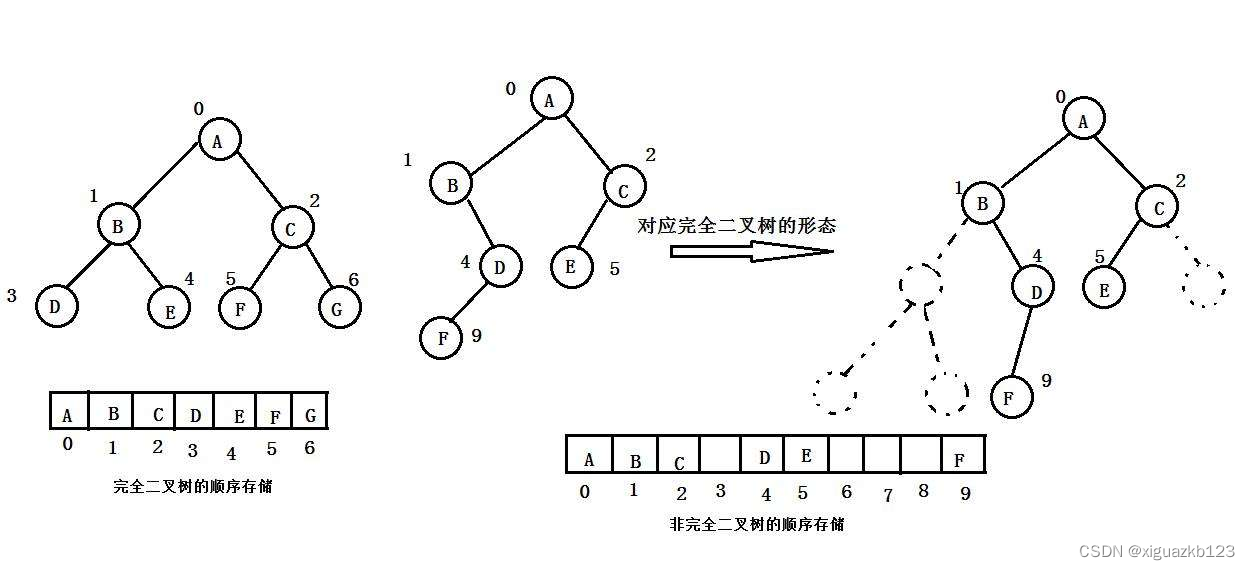
3.2 堆的概念及结构 (完全二叉树)

大堆 :树中一个树及子树中,任何一个父亲都大于等于孩子
小堆 :树中一个树及子树中,任何一个父亲都小于等于孩子
堆的性质:
- 堆中某个节点的值总是不大于或不小于其父节点的值;
- 堆总是一棵完全二叉树。
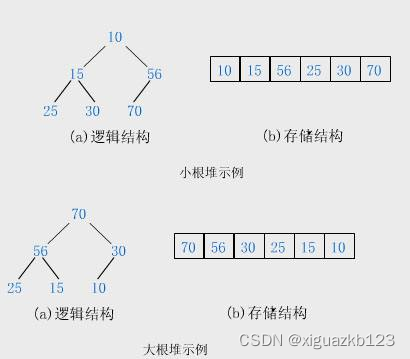

3.3 堆的实现
3.3.1 堆向下调整
现在我们给出一个数组,逻辑上看做一颗完全二叉树。我们通过从根节点开始的向下调整算法可以把它调整成一个小堆。
向下调整算法有一个前提:左右子树必须是一个堆,才能调整。
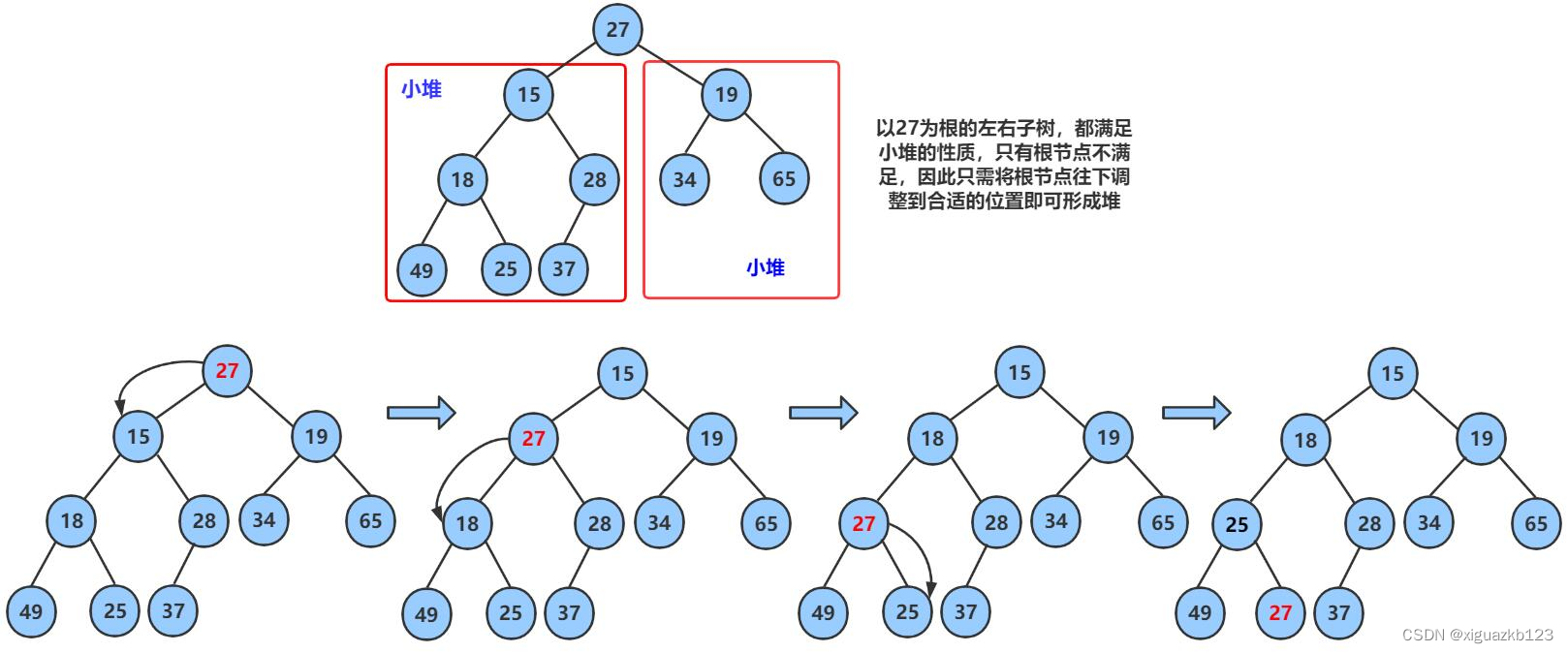
//堆的向下调整(小堆)
void AdjustDown(int* a, int n, int parent)
{
int child = parent * 2 + 1;
while (child < n)
{
// 选出左右孩子中小的那一个
if (child + 1 < n && a[child + 1] < a[child])
{
++child;
}
// 如果小的孩子小于父亲,则交换,并继续向下调整
if (a[child] < a[parent])
{
Swap(&a[child], &a[parent]);
parent = child;
child = parent * 2 + 1;
}
else
{
break;
}
}
}3.3.2 堆向上调整
//堆的向上调整(小堆)
void AdjustUp(int* a, int child)
{
assert(a);
int parent = (child - 1) / 2;
while (child > 0)
{
if (a[child] < a[parent])
{
Swap(&a[child], &a[parent]);
child = parent;
parent = (child - 1) / 2;
}
else
{
break;
}
}
}3.3.2堆的创建
下面我们给出一个数组,这个数组逻辑上可以看做一颗完全二叉树,但是还不是一个堆,现在我们通过算法,把它构建成一个堆。根节点左右子树不是堆,我们怎么调整呢?这里我们从倒数的第一个非叶子节点的子树开始调整,一直调整到根节点的树,就可以调整成堆。

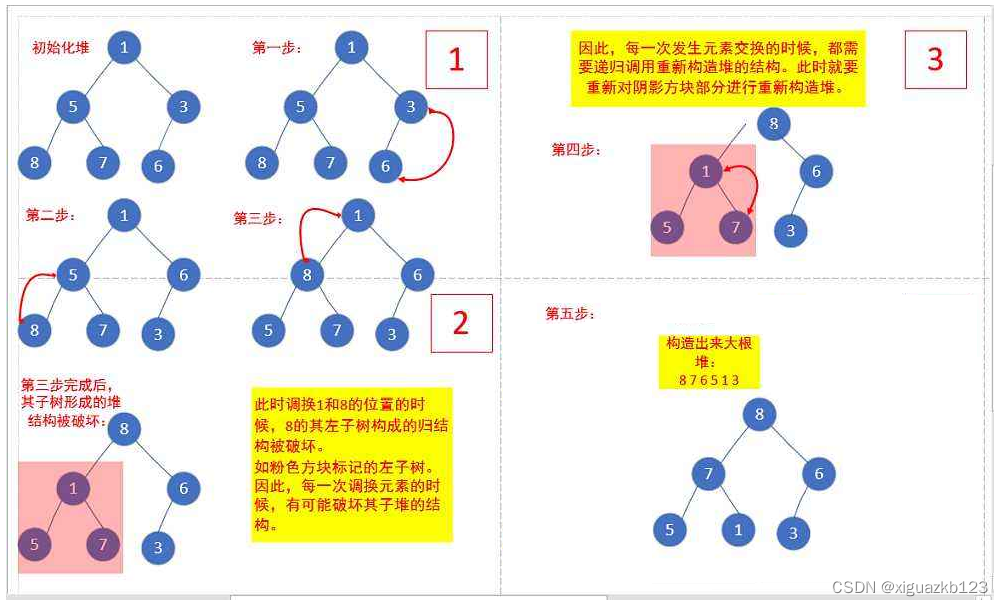
3.3.3 建堆时间复杂度
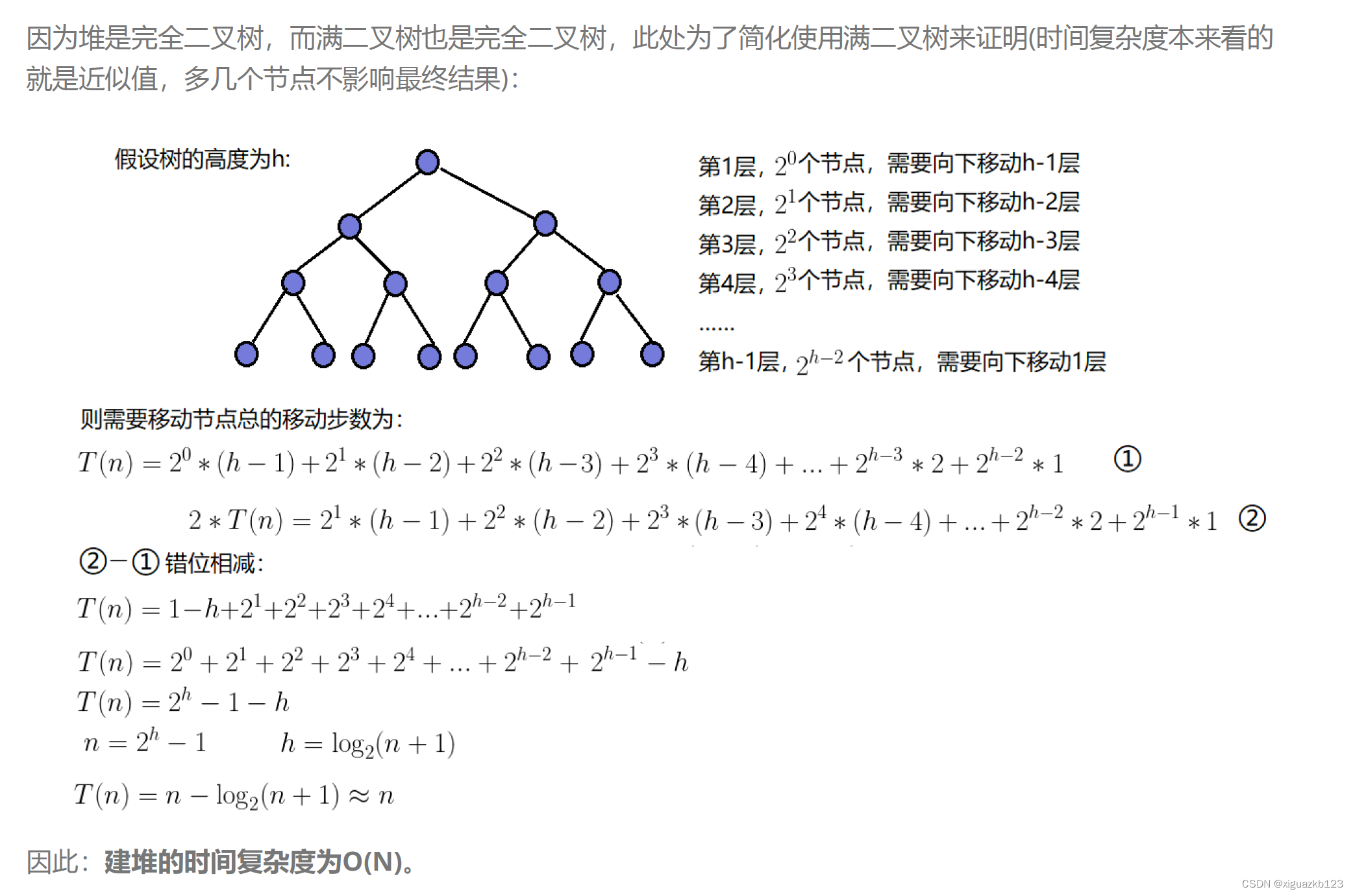
3.3.4 堆的插入
先插入一个10到数组的尾上,再进行向上调整算法,直到满足堆。

void HeapPush(HP* hp, HPDataType x)
{
assert(hp);
HeapCheckCapacity(hp);
hp->a[hp->size] = x;
hp->size++;
AdjustUp(hp->a, hp->size - 1);
}3.3.5 堆的删除
删除堆是删除堆顶的数据,将堆顶的数据根最后一个数据一换,然后删除数组最后一个数据,再进行向下调整算法。
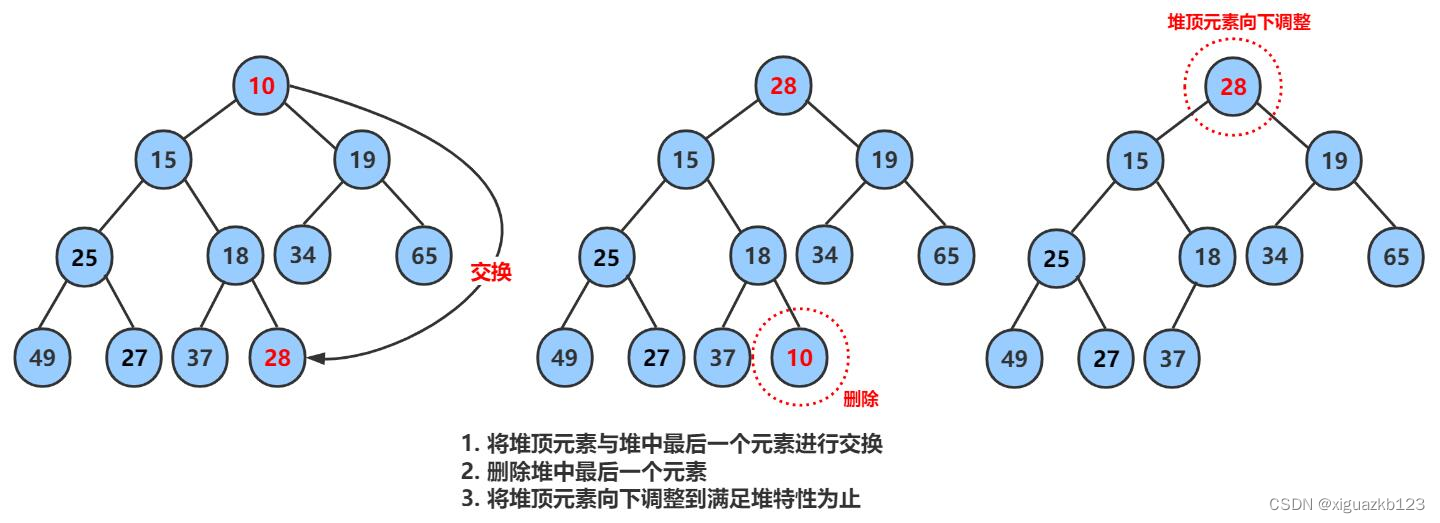
3.3.6 堆的代码实现
#pragma once
#include <stdio.h>
#include <assert.h>
#include <stdlib.h>
#include <stdbool.h>
typedef int HPDataType;
typedef struct Heap
{
HPDataType* a;
int size;
int capacity;
}HP;
// 堆的初始化
void HeapInit(HP* hp);
// 堆的销毁
void HeapDestroy(HP* hp);
// 堆的插入
void HeapPush(HP* hp, HPDataType x);
// 堆的删除
void HeapPop(HP* hp);
// 取堆顶的数据
HPDataType HeapTop(HP* hp);
// 堆的数据个数
int HeapSize(HP* hp);
// 堆的判空
bool HeapEmpty(HP* hp);
// 堆的打印
void HeapPrint(HP* hp);
// 堆的扩容
void HeapCheckCapacity(HP* hp);
// 堆的向下调整
void AdjustDown(int* a, int n, int parent);
// 堆的向上调整
void AdjustUp(int* a, int child);#define _CRT_SECURE_NO_WARNINGS 1
#include"Heap.h"
void Swap(HPDataType* px, HPDataType* py)
{
HPDataType tmp = *px;
*px = *py;
*py = tmp;
}
void HeapInit(HP* hp)
{
assert(hp);
hp->a = NULL;
hp->size = hp->capacity = 0;
}
void HeapDestroy(HP* hp)
{
assert(hp);
free(hp->a);
hp->capacity = hp->size = 0;
}
void HeapCheckCapacity(HP* hp)
{
assert(hp);
if (hp->size == hp->capacity)
{
size_t newCapacity = hp->capacity == 0 ? 4 : hp->capacity * 2;
HPDataType* tmp = realloc(hp->a, sizeof(HPDataType) * newCapacity);
if (tmp == NULL)
{
printf("realloc fail\n");
exit(-1);
}
hp->a = tmp;
hp->capacity = newCapacity;
}
}
void HeapPush(HP* hp, HPDataType x)
{
assert(hp);
HeapCheckCapacity(hp);
hp->a[hp->size] = x;
hp->size++;
AdjustUp(hp->a, hp->size - 1);
}
bool HeapEmpty(HP* hp)
{
assert(hp);
return hp->size == 0;
}
int HeapSize(HP* hp)
{
assert(hp);
return hp->size;
}
HPDataType HeapTop(HP* hp)
{
assert(hp);
assert(!HeapEmpty(hp));
return hp->a[0];
}
void AdjustDown(int* a, int n, int parent)
{
int child = parent * 2 + 1;
while (child < n)
{
// 选出左右孩子中小的那一个
if (child + 1 < n && a[child + 1] < a[child])
{
++child;
}
// 如果小的孩子小于父亲,则交换,并继续向下调整
if (a[child] > a[parent])
{
Swap(&a[child], &a[parent]);
parent = child;
child = parent * 2 + 1;
}
else
{
break;
}
}
}
void HeapPop(HP* hp)
{
assert(hp);
assert(!HeapEmpty(hp));
Swap(&hp->a[0], &hp->a[hp->size - 1]);
hp->size--;
AdjustDown(hp->a, hp->size, 0);
}
void HeapPrint(HP* hp)
{
for (int i = 0; i < hp->size; ++i)
{
printf("%d ", hp->a[i]);
}
printf("\n");
}
void AdjustUp(int* a, int child)
{
assert(a);
int parent = (child - 1) / 2;
while (child > 0)
{
if (a[child] < a[parent])
{
Swap(&a[child], &a[parent]);
child = parent;
parent = (child - 1) / 2;
}
else
{
break;
}
}
}3.4 堆的应用
3.4.1 堆排序
堆排序即利用堆的思想来进行排序,总共分为两个步骤:
1. 建堆
- 升序:建大堆
- 降序:建小堆
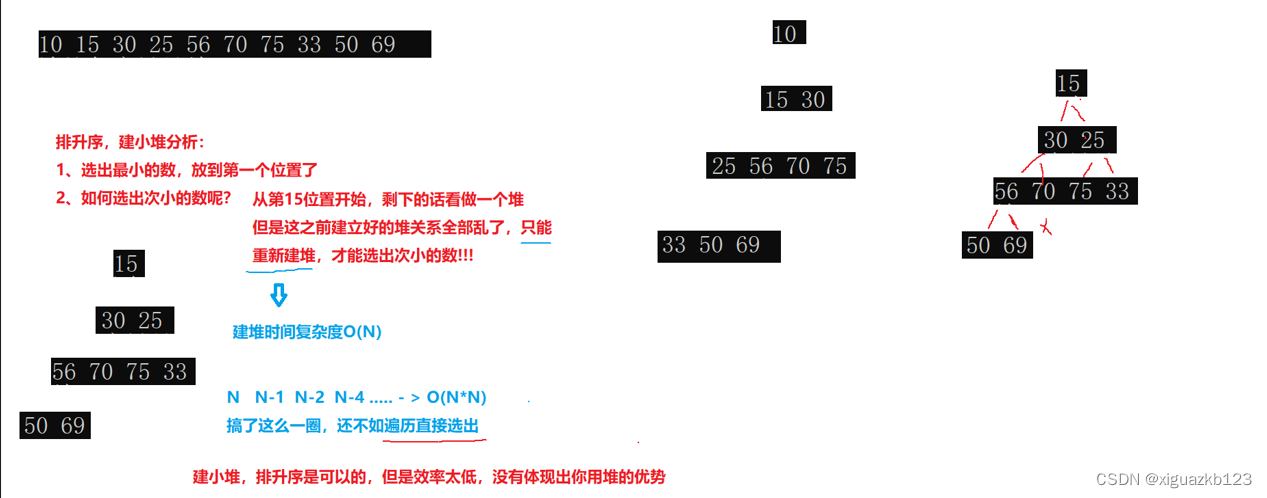
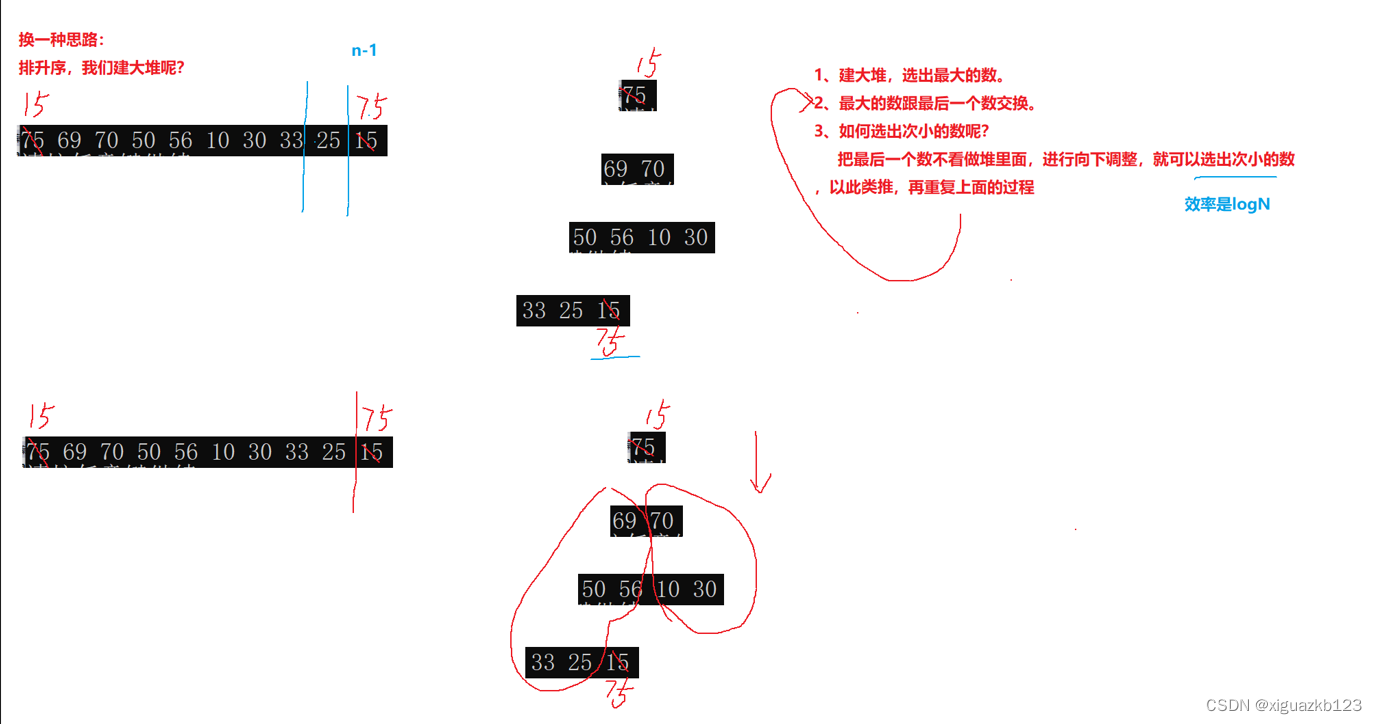
2. 利用堆删除思想来进行排序
建堆和堆删除中都用到了向下调整,因此掌握了向下调整,就可以完成堆排序。
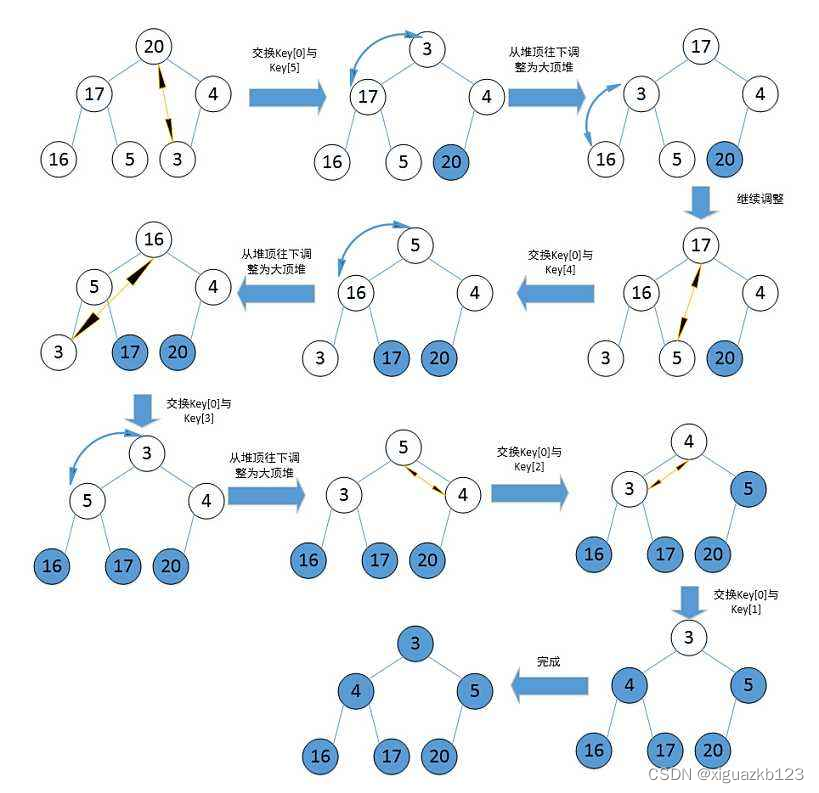
堆排序代码
Heap.h
#pragma once
#include <stdio.h>
#include <assert.h>
#include <stdlib.h>
#include <stdbool.h>
typedef int HPDataType;
typedef struct Heap
{
HPDataType* a;
int size;
int capacity;
}HP;
// 堆的初始化
void HeapInit(HP* hp);
// 堆的销毁
void HeapDestroy(HP* hp);
// 堆的插入
void HeapPush(HP* hp, HPDataType x);
// 堆的删除
void HeapPop(HP* hp);
// 取堆顶的数据
HPDataType HeapTop(HP* hp);
// 堆的数据个数
int HeapSize(HP* hp);
// 堆的判空
bool HeapEmpty(HP* hp);
// 堆的打印
void HeapPrint(HP* hp);
// 堆的扩容
void HeapCheckCapacity(HP* hp);
// 堆的向上调整
void AdjustUp(int* a, int child);
// 堆的向下调整
void AdjustDown(int* a, int n, int parent);
// 交换函数
void Swap(HPDataType* px, HPDataType* py);Heap.c
#define _CRT_SECURE_NO_WARNINGS 1
#include"Heap.h"
void Swap(HPDataType* px, HPDataType* py)
{
HPDataType tmp = *px;
*px = *py;
*py = tmp;
}
void HeapInit(HP* hp)
{
assert(hp);
hp->a = NULL;
hp->size = hp->capacity = 0;
}
void HeapDestroy(HP* hp)
{
assert(hp);
free(hp->a);
hp->capacity = hp->size = 0;
}
void HeapCheckCapacity(HP* hp)
{
assert(hp);
if (hp->size == hp->capacity)
{
size_t newCapacity = hp->capacity == 0 ? 4 : hp->capacity * 2;
HPDataType* tmp = realloc(hp->a, sizeof(HPDataType) * newCapacity);
if (tmp == NULL)
{
printf("realloc fail\n");
exit(-1);
}
hp->a = tmp;
hp->capacity = newCapacity;
}
}
void AdjustUp(int* a, int child)
{
assert(a);
int parent = (child - 1) / 2;
while (child > 0)
{
if (a[child] < a[parent])
{
Swap(&a[child], &a[parent]);
child = parent;
parent = (child - 1) / 2;
}
else
{
break;
}
}
}
void HeapPush(HP* hp, HPDataType x)
{
assert(hp);
HeapCheckCapacity(hp);
hp->a[hp->size] = x;
hp->size++;
AdjustUp(hp->a, hp->size - 1);
}
bool HeapEmpty(HP* hp)
{
assert(hp);
return hp->size == 0;
}
int HeapSize(HP* hp)
{
assert(hp);
return hp->size;
}
HPDataType HeapTop(HP* hp)
{
assert(hp);
assert(!HeapEmpty(hp));
return hp->a[0];
}
void AdjustDown(int* a, int n, int parent)
{
int child = parent * 2 + 1;
while (child < n)
{
// 选出左右孩子中小的那一个
if (child + 1 < n && a[child + 1] < a[child])
{
++child;
}
// 如果小的孩子小于父亲,则交换,并继续向下调整
if (a[child] < a[parent])
{
Swap(&a[child], &a[parent]);
parent = child;
child = parent * 2 + 1;
}
else
{
break;
}
}
}
void HeapPop(HP* hp)
{
assert(hp);
assert(!HeapEmpty(hp));
Swap(&hp->a[0], &hp->a[hp->size - 1]);
hp->size--;
AdjustDown(hp->a, hp->size, 0);
}
void HeapPrint(HP* hp)
{
for (int i = 0; i < hp->size; ++i)
{
printf("%d ", hp->a[i]);
}
printf("\n");
}test.c
#include "Heap.h"
// 升序 空间复杂度是多少? O(N) 要求优化到O(1) -> 不能用Heap
//void HeapSort(int* a, int n)
//{
// HP hp;
// HeapInit(&hp);
// // 建议一个N个小堆
// for (int i = 0; i < n; ++i)
// {
// HeapPush(&hp, a[i]);
// }
//
// // Pop N 次
// for (int i = 0; i < n; ++i)
// {
// a[i] = HeapTop(&hp);
// HeapPop(&hp);
// }
//
// HeapDestroy(&hp);
//}
// 升序
void HeapSort(int* a, int n)
{
// 把a构建成小堆
// 方法1:
/*for (int i = 1; i < n; ++i)
{
AdjustUp(a, i);
}*/
// 方法2:
// O(N)
for (int i = (n - 1 - 1) / 2; i >= 0; --i)
{//n-1是最后一个节点,(n-1-1)/2是最后一个节点的父节点
AdjustDown(a, n, i);//小堆
}
//
// 依次选数,调堆
// O(N*logN)
for (int end = n - 1; end > 0; --end)
{
Swap(&a[end], &a[0]);
// 再调堆,选出次小的数
AdjustDown(a, end, 0);
}
}
int main()
{
//TestTopk();
int a[] = { 70, 56, 30, 25, 15, 10, 75, 33, 50, 69 };
for (int i = 0; i < sizeof(a) / sizeof(a[0]); ++i)
{
printf("%d ", a[i]);
}
printf("\n");
HeapSort(a, sizeof(a) / sizeof(a[0]));
for (int i = 0; i < sizeof(a) / sizeof(a[0]); ++i)
{
printf("%d ", a[i]);
}
printf("\n");
return 0;
}
3.4.2 TOP-K问题
TOP-K问题:即求数据结合中前K个最大的元素或者最小的元素,一般情况下数据量都比较大。
比如:专业前10名、世界500强、富豪榜、游戏中前100的活跃玩家等。
对于Top-K问题,能想到的最简单直接的方式就是排序,但是:如果数据量非常大,排序就不太可取了(可能 数据都不能一下子全部加载到内存中)。最佳的方式就是用堆来解决,基本思路如下:
1. 用数据集合中前K个元素来建堆
- 前k个最大的元素,则建小堆
- 前k个最小的元素,则建大堆
2. 用剩余的N-K个元素依次与堆顶元素来比较,不满足则替换堆顶元素
将剩余N-K个元素依次与堆顶元素比完之后,堆中剩余的K个元素就是所求的前K个最小或者最大的元素。
首先思考下建立大堆还是小堆?
建小堆,因为如果建大堆,最大的数可能挡在头的位置,其他9个次大的数就进不来。
思路:
1、用前K个数建立一个K个数的小堆。
2、剩下的N-K个数,依次跟堆顶的数据进行比较,如果比堆顶数据大,就替换堆顶的数据,再向下调整
3、最后堆里面K个数就是最大的K个数
#include "Heap.h"
// 在N个数找出最大的前K个 or 在N个数找出最小的前K个
void PrintTopK(int* a, int n, int k)
{
// 1. 建堆--用a中前k个元素建堆
// 2. 将剩余n-k个元素依次与堆顶元素交换,不满则则替换
HP hp;
HeapInit(&hp);
// 创建一个K个数的小堆
for (int i = 0; i < k; ++i)
{
HeapPush(&hp, a[i]);
}
// 剩下的N-K个数跟堆顶的数据比较,比他大,就替换他进堆
for (int i = k; i < n; ++i)
{
if (a[i] > HeapTop(&hp))
{
//HeapPop(&hp);
//HeapPush(&hp, a[i]);
hp.a[0] = a[i];
AdjustDown(hp.a, hp.size, 0);
}
}
HeapPrint(&hp);
HeapDestroy(&hp);
}
void TestTopk()
{
int n = 1000000;
int* a = (int*)malloc(sizeof(int)*n);
srand(time(0));
for (size_t i = 0; i < n; ++i)
{
a[i] = rand() % 1000000;
}
// 再去设置10个比100w大的数
a[5] = 1000000 + 1;
a[1231] = 1000000 + 2;
a[5355] = 1000000 + 3;
a[51] = 1000000 + 4;
a[15] = 1000000 + 5;
a[2335] = 1000000 + 6;
a[9999] = 1000000 + 7;
a[76] = 1000000 + 8;
a[423] = 1000000 + 9;
a[3144] = 1000000 + 10;
PrintTopK(a, n, 10);
}
void TestHeap()
{
int a[] = { 70, 56, 30, 25, 15, 10, 75 };
HP hp;
HeapInit(&hp);
for (int i = 0; i < sizeof(a) / sizeof(a[0]); ++i)
{
HeapPush(&hp, a[i]);
}
HeapPrint(&hp);
HeapPop(&hp);
HeapPrint(&hp);
HeapPop(&hp);
HeapPrint(&hp);
HeapPop(&hp);
HeapPrint(&hp);
HeapPop(&hp);
HeapPrint(&hp);
HeapDestroy(&hp);
}
// 升序 空间复杂度是多少? 要求优化到O(1) -> 不能用Heap
//void HeapSort(int* a, int n)
//{
// HP hp;
// HeapInit(&hp);
// // 建议一个N个小堆
// for (int i = 0; i < n; ++i)
// {
// HeapPush(&hp, a[i]);
// }
//
// // Pop N 次
// for (int i = 0; i < n; ++i)
// {
// a[i] = HeapTop(&hp);
// HeapPop(&hp);
// }
//
// HeapDestroy(&hp);
//}
int main()
{
//TestTopk();
int a[] = { 70, 56, 30, 25, 15, 10, 75 };
for (int i = 0; i < sizeof(a) / sizeof(a[0]); ++i)
{
printf("%d ", a[i]);
}
printf("\n");
HeapSort(a, sizeof(a) / sizeof(a[0]));
for (int i = 0; i < sizeof(a) / sizeof(a[0]); ++i)
{
printf("%d ", a[i]);
}
printf("\n");
return 0;
}4.二叉树链式结构及其实现
4.1 前置说明
在学习二叉树的基本操作前,需先要创建一棵二叉树,然后才能学习其相关的基本操作。
由于现在大家对二叉树结构掌握还不够深入,为了降低大家学习成本,此处手动快速创建一棵简单的二叉树,快速进入二叉树操作学习,等二叉树结构了解的差不多时,我们反过头再来研究二叉树真正的创建方式。
typedef char BTDataType;
typedef struct BinaryTreeNode
{
struct BinaryTreeNode* left;
struct BinaryTreeNode* right;
BTDataType data;
}BTNode;
BTNode* CreatBinaryTree()
{
BTNode* nodeA = BuyNode('A');
BTNode* nodeB = BuyNode('B');
BTNode* nodeC = BuyNode('C');
BTNode* nodeD = BuyNode('D');
BTNode* nodeE = BuyNode('E');
BTNode* nodeF = BuyNode('F');
nodeA->left = nodeB;
nodeA->right = nodeC;
nodeB->left = nodeD;
nodeC->left = nodeE;
nodeC->right = nodeF;
return nodeA;
}注意:上述代码并不是创建二叉树的方式,真正创建二叉树方式后序详解重点讲解。
再看二叉树基本操作前,再回顾下二叉树的概念,二叉树是:
1. 空树
2. 非空:根节点,根节点的左子树、根节点的右子树组成的。
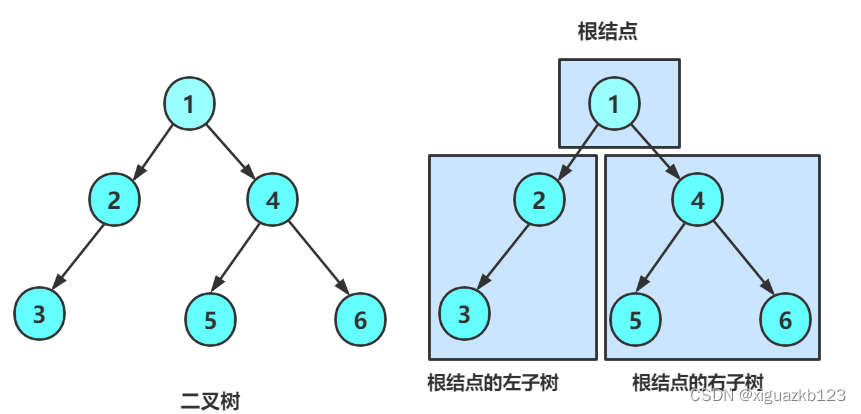 从概念中可以看出,二叉树定义是递归式的,因此后序基本操作中基本都是按照该概念实现的。
从概念中可以看出,二叉树定义是递归式的,因此后序基本操作中基本都是按照该概念实现的。
4.2二叉树的遍历
4.2.1 前序、中序以及后序遍历
学习二叉树结构,最简单的方式就是遍历。所谓二叉树遍历(Traversal)是按照某种特定的规则,依次对二叉 树中的节点进行相应的操作,并且每个节点只操作一次。访问结点所做的操作依赖于具体的应用问题。 遍历是二叉树上最重要的运算之一,也是二叉树上进行其它运算的基础。

按照规则,二叉树的遍历有:前序/中序/后序的递归结构遍历:
- 1. 前序遍历(Preorder Traversal 亦称先序遍历)——访问根结点的操作发生在遍历其左右子树之前。
- 2. 中序遍历(Inorder Traversal)——访问根结点的操作发生在遍历其左右子树之中(间)。
- 3. 后序遍历(Postorder Traversal)——访问根结点的操作发生在遍历其左右子树之后。
由于被访问的结点必是某子树的根,所以N(Node)、L(Left subtree)和R(Right subtree)又可解释为根、根的左子树和根的右子树。NLR、LNR和LRN分别又称为先根遍历、中根遍历和后根遍历。
前序遍历:
![]()
中序遍历:

后序遍历:

// 二叉树前序遍历
void PreOrder(BTNode* root);
// 二叉树中序遍历
void InOrder(BTNode* root);
// 二叉树后序遍历
void PostOrder(BTNode* root);
void PreOrder(BTNode* root)
{
if (root == NULL)
{
printf("NULL");
return;
}
printf("%c ", root->data);
PreOrder(root->left);
PreOrder(root->right);
}
void InOrder(BTNode* root)
{
if (root == NULL)
{
printf("NULL");
return;
}
InOrder(root->left);
printf("%C ", root->data);
InOrder(root->right);
}
void PostOrder(BTNode* root)
{
if (root == NULL)
{
printf("NULL ");
return;
}
PostOrder(root->left);
PostOrder(root->right);
printf("%C ", root->data);
}
前序遍历递归图解:

4.2.2 层序遍历
层序遍历:除了先序遍历、中序遍历、后序遍历外,还可以对二叉树进行层序遍历。
设二叉树的根节点所在层数为1,层序遍历就是从所在二叉树的根节点出发,首先访问第一层的树根节点,然后从左到右访问第2层上的节点,接着是第三层的节点,以此类推,自上而下,自左至右逐层访问树的结点的过程就是层序遍历。
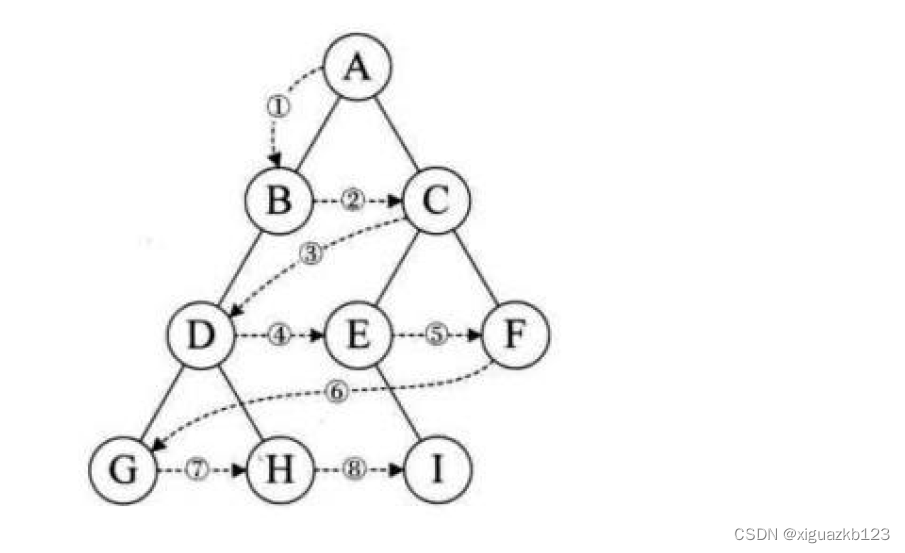
队列中的数据类型是树的节点。
#pragma once
#include <stdio.h>
#include <assert.h>
#include <stdlib.h>
#include <stdbool.h>
//前置声明
struct BinaryTreeNode;
typedef struct BinaryTreeNode* QDataType;
//链式结构:表示队列
typedef struct QueueNode
{
struct QueueNode* next;//指针域
QDataType data;//数据域
}QueueNode;
//队列链表的头指针与尾指针
typedef struct Queue
{
QueueNode* head;
QueueNode* tail;
}Queue;1、先入根
2、当前节点出来,把孩子带进去,这样上一层节点出的时候,带入下一层。
3、队列为空,说明最后一层没有节点了,遍历结束
void LevelOrder(BTNode* root)
{
if (root == NULL)
return;
Queue q;
QueueInit(&q);
QueuePush(&q, root);
while (!QueueEmpty(&q))
{
BTNode* front = QueueFront(&q);
QueuePop(&q);
printf("%c ", front->data);
//孩子带进队列
if (front->left)
QueuePush(&q, front->left);
if (front->right)
QueuePush(&q, front->right);
}
printf("\n");
QueueDestroy(&q);
}练习:请写出下面的前序/中序/后序/层序遍历
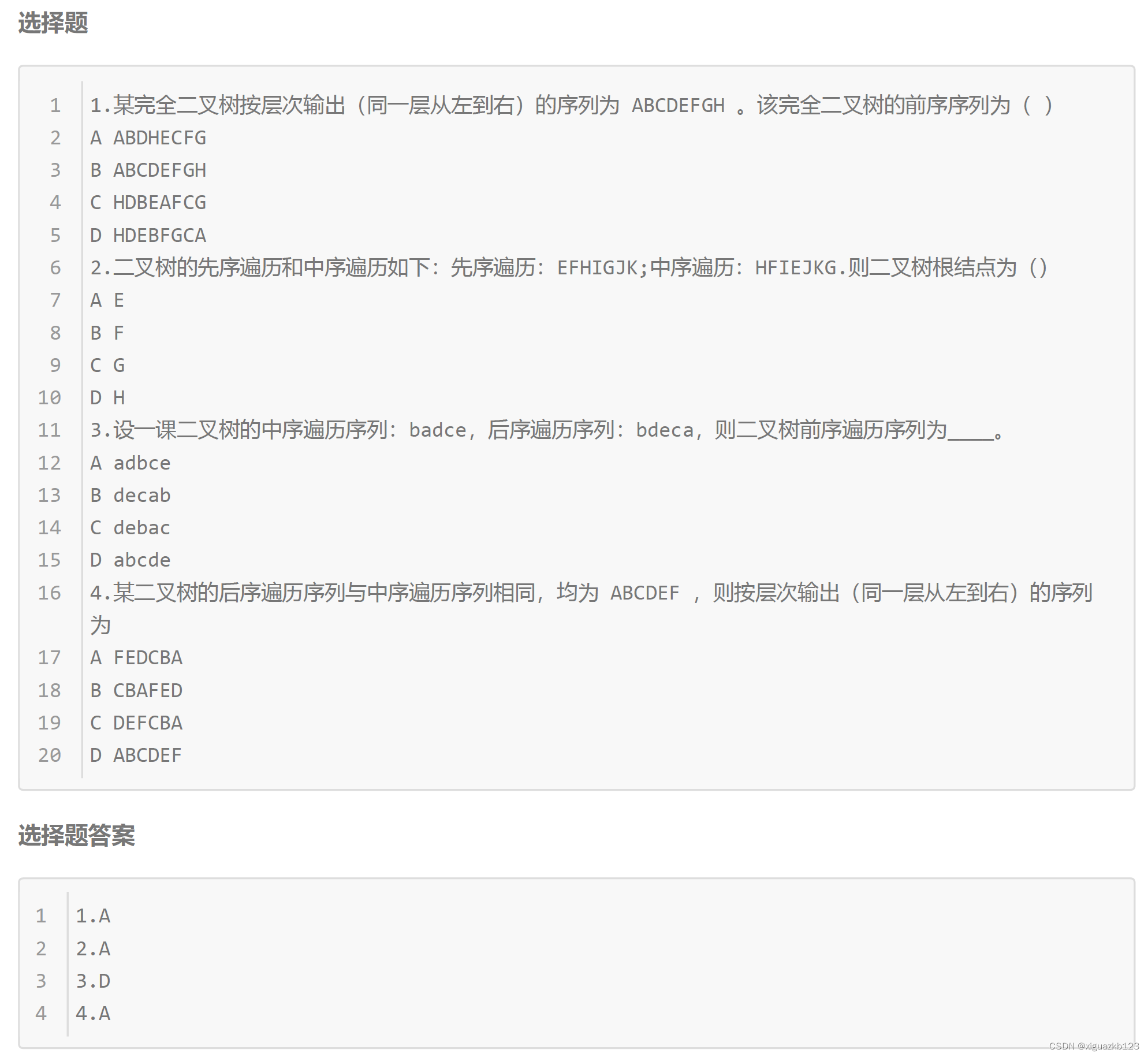
4.5 二叉树的创建和销毁
// 二叉树销毁
void BinaryTreeDestory(BTNode** root);
// 判断二叉树是否是完全二叉树
int BinaryTreeComplete(BTNode* root);
void BinaryTreeDestory(BTNode* root)
{
if (root == NULL)
{
return;
}
BinaryTreeDestory(root->left);
BinaryTreeDestory(root->right);
free(root);
//为了保证接口一致,注意需要在外边置空(形参改变不会影响实参)
//BinaryTreeDestory(root);
//root = NULL;
}
bool BinaryTreeComplete(BTNode* root)
{
//层序遍历
Queue q;
QueueInit(&q);
QueuePush(&q, root);
while (!QueueEmpty(&q))
{
BTNode* front = QueueFront(&q);
QueuePop(&q);
if (front == NULL)
{
break;
}
else
{
//孩子带进队列,空的也要带
QueuePush(&q, front->left);
QueuePush(&q, front->right);
}
}
// 遇到空了以后,检查队列中剩下的节点
// 1、剩下全是空,则是完全二叉树
// 2、剩下存在非空,则不是完全二叉树
while (!QueueEmpty(&q))
{
BTNode* front = QueueFront(&q);
QueuePop(&q);
if (front)
{
QueueDestroy(&q);
return false;
}
}
QueueDestroy(&q);
return true;
}5.全部代码
BinaryTree.c
#define _CRT_SECURE_NO_WARNINGS 1
#include"BinaryTree.h"
#include"Queue.h"
BTNode* BuyNode(BTDataType x)
{
BTNode* node = (BTNode*)malloc(sizeof(BTNode));
if (node == NULL)
{
printf("malloc fail\n");
exit(-1);
}
node->data = x;
node->left = node->right = NULL;
return node;
}
BTNode* CreatBinaryTree()
{
BTNode* nodeA = BuyNode('A');
BTNode* nodeB = BuyNode('B');
BTNode* nodeC = BuyNode('C');
BTNode* nodeD = BuyNode('D');
BTNode* nodeE = BuyNode('E');
BTNode* nodeF = BuyNode('F');
BTNode* nodeG = BuyNode('G');
nodeA->left = nodeB;
nodeA->right = nodeC;
nodeB->left = nodeD;
nodeC->left = nodeE;
nodeC->right = nodeF;
nodeF->right = nodeG;
return nodeA;
}
void PreOrder(BTNode* root)
{
if (root == NULL)
{
printf("NULL");
return;
}
printf("%c ", root->data);
PreOrder(root->left);
PreOrder(root->right);
}
void InOrder(BTNode* root)
{
if (root == NULL)
{
printf("NULL");
return;
}
InOrder(root->left);
printf("%C ", root->data);
InOrder(root->right);
}
void PostOrder(BTNode* root)
{
if (root == NULL)
{
printf("NULL ");
return;
}
PostOrder(root->left);
PostOrder(root->right);
printf("%C ", root->data);
}
void LevelOrder(BTNode* root)
{
if (root == NULL)
return;
Queue q;
QueueInit(&q);
QueuePush(&q, root);
while (!QueueEmpty(&q))
{
BTNode* front = QueueFront(&q);
QueuePop(&q);
printf("%c ", front->data);
//孩子带进队列
if (front->left)
QueuePush(&q, front->left);
if (front->right)
QueuePush(&q, front->right);
}
printf("\n");
QueueDestroy(&q);
}
// 判断二叉树是否是完全二叉树
bool BinaryTreeComplete(BTNode* root)
{
//层序遍历
Queue q;
QueueInit(&q);
QueuePush(&q, root);
while (!QueueEmpty(&q))
{
BTNode* front = QueueFront(&q);
QueuePop(&q);
if (front == NULL)
{
break;
}
else
{
//孩子带进队列,空的也要带
QueuePush(&q, front->left);
QueuePush(&q, front->right);
}
}
// 遇到空了以后,检查队列中剩下的节点
// 1、剩下全是空,则是完全二叉树
// 2、剩下存在非空,则不是完全二叉树
while (!QueueEmpty(&q))
{
BTNode* front = QueueFront(&q);
QueuePop(&q);
if (front)
{
QueueDestroy(&q);
return false;
}
}
QueueDestroy(&q);
return true;
}
int BinaryTreeSize(BTNode* root)
{
//结点个数 = 左子树的结点个数 + 右子树的结点个数 + 根结点
return root == NULL ? 0 :
BinaryTreeSize(root->left)
+ BinaryTreeSize(root->right)
+ 1;
}
int BinaryTreeLeafSize(BTNode* root)
{
if (root == NULL)
{
return 0;
}
if (root->left == NULL && root->right == NULL)
{
return 1;
}
return BinaryTreeLeafSize(root->left) + BinaryTreeLeafSize(root->right);
}
int BinaryTreeLevelKSize(BTNode* root, int k)
{
/*if (k < 1)
{
return 0;
}*/
assert(k >= 1);
if (root == NULL)
{
return 0;
}
if (k == 1)
{
return 1;
}
// root不等空,k也不等于1,说明root这颗树的第k节点在子树里面
// 转换成求左右子树的第k-1等的节点数量
return BinaryTreeLevelKSize(root->left, k - 1)
+ BinaryTreeLevelKSize(root->right, k - 1);
}
int BinaryTreeDepth(BTNode* root)
{
if (root == NULL)
{
return 0;
}
//return BinaryTreeDepth(root->left) > BinaryTreeDepth(root->right) ? BinaryTreeDepth(root->left) + 1 : BinaryTreeDepth(root->right) + 1;
//会有大量的计算
int leftDepth = BinaryTreeDepth(root->left);
int rightDepth = BinaryTreeDepth(root->right);
return leftDepth > rightDepth ? leftDepth + 1 : rightDepth + 1;
}
BTNode* BinaryTreeFind(BTNode* root, BTDataType x)
{
if (root == NULL)
return NULL;
if (root->data == x)
return root;
BTNode* leftRet = BinaryTreeFind(root->left, x);
if (leftRet)
return leftRet;
BTNode* rightRet = BinaryTreeFind(root->right, x);
if (rightRet)
return rightRet;
return NULL;//根结点,左子树,右子树中没有找到
}
void BinaryTreeDestory(BTNode* root)
{
if (root == NULL)
{
return;
}
BinaryTreeDestory(root->left);
BinaryTreeDestory(root->right);
free(root);
//为了保证接口一致,注意需要在外边置空(形参改变不会影响实参)
//BinaryTreeDestory(root);
//root = NULL;
}BinaryTree.h
#pragma once
#include <stdio.h>
#include <assert.h>
#include <stdlib.h>
#include <stdbool.h>
typedef char BTDataType;
typedef struct BinaryTreeNode
{
struct BinaryTreeNode* left;
struct BinaryTreeNode* right;
BTDataType data;
}BTNode;
//二叉树的构建
BTNode* CreatBinaryTree();
//二叉树的扩容
BTNode* BuyNode(BTDataType x);
//二叉树前序遍历
void PreOrder(BTNode* root);
// 二叉树中序遍历
void InOrder(BTNode* root);
// 二叉树后序遍历
void PostOrder(BTNode* root);
//层序遍历
void LevelOrder(BTNode* root);
//二叉树结点个数
int BinaryTreeSize(BTNode* root);
// 二叉树叶子节点个数
int BinaryTreeLeafSize(BTNode* root);
// 二叉树第k层节点个数
int BinaryTreeLevelKSize(BTNode* root, int k);
// 二叉树深度/高度
int BinaryTreeDepth(BTNode* root);
// 二叉树查找值为x的节点
BTNode* BinaryTreeFind(BTNode* root, BTDataType x);
// 判断二叉树是否是完全二叉树
bool BinaryTreeComplete(BTNode* root);
// 二叉树销毁
void BinaryTreeDestory(BTNode* root);Queue.c
#define _CRT_SECURE_NO_WARNINGS 1
#include"Queue.h"
void QueueInit(Queue* pq)
{
assert(pq);
pq->head = NULL;
pq->tail = NULL;
}
void QueueDestroy(Queue* pq)
{
assert(pq);
QueueNode* cur = pq->head;// QueueNode* cur =NULL
while (cur != NULL)
{
QueueNode* next = cur->next;
free(cur);
cur = next;
}
pq->head = pq->tail = NULL;
}
QueueNode* BuyQueueNode(QDataType x)
{
QueueNode* newnode = (QueueNode*)malloc(sizeof(QueueNode));
if (newnode == NULL)
{
printf("malloc fail\n");
exit(-1);
}
newnode->data = x;
newnode->next = NULL;
return newnode;
}
void QueuePush(Queue* pq, QDataType x)
{
assert(pq);
QueueNode* newnode = BuyQueueNode(x);
if (pq->head == NULL)
{
pq->head = pq->tail = newnode;
}
else
{
pq->tail->next = newnode;
pq->tail = newnode;
}
}
void QueuePrint(Queue* pq)
{
QueueNode* cur = pq->head;
while (cur)
{
printf("%d ", cur->data);
cur = cur->next;
}
printf("\n");
}
void QueuePop(Queue* pq)
{
assert(pq);
//if (pq->head == NULL)
// return;
assert(!QueueEmpty(pq));
QueueNode* next = pq->head->next;
free(pq->head);
pq->head = next;
if (pq->head == NULL)
{
pq->tail = NULL;
}
}
QDataType QueueFront(Queue* pq)
{
assert(pq);
assert(!QueueEmpty(pq));
return pq->head->data;
}
QDataType QueueBack(Queue* pq)
{
assert(pq);
assert(!QueueEmpty(pq));
return pq->tail->data;
}
int QueueSize(Queue* pq)
{
assert(pq);
int n = 0;
QueueNode* cur = pq->head;
while (cur)
{
++n;
cur = cur->next;
}
return n;
}
bool QueueEmpty(Queue* pq)
{
assert(pq);
return pq->head == NULL;
}Queue.h
#pragma once
#include <stdio.h>
#include <assert.h>
#include <stdlib.h>
#include <stdbool.h>
//前置声明
struct BinaryTreeNode;
typedef struct BinaryTreeNode* QDataType;
//链式结构:表示队列
typedef struct QueueNode
{
struct QueueNode* next;//指针域
QDataType data;//数据域
}QueueNode;
//队列链表的头指针与尾指针
typedef struct Queue
{
QueueNode* head;
QueueNode* tail;
}Queue;
//初始化队列
void QueueInit(Queue* pq);
//队尾入队列
void QueuePush(Queue* pq, QDataType x);
//队头出队列
void QueuePop(Queue* pq);
//获取队列头部元素
QDataType QueueFront(Queue* pq);
//获取队列队尾元素
QDataType QueueBack(Queue* pq);
//获取队列中有效元素个数
int QueueSize(Queue* pq);
//队列打印
void QueuePrint(Queue* pq);
//队列判空
bool QueueEmpty(Queue* pq);
//销毁队列
void QueueDestroy(Queue* pq);
Test.c
#define _CRT_SECURE_NO_WARNINGS 1
#include"BinaryTree.h"
#include"Queue.h"
int main()
{
BTNode* root = CreatBinaryTree();
//PreOrder(root);
//printf("\n");
//InOrder(root);
//printf("\n");
/*int n1 = 0;
BinaryTreeSize(root, &n1);
printf("TreeSize:%d\n", n1);
int n2 = 0;
BinaryTreeSize(root, &n2);
printf("TreeSize:%d\n", n2);*/
//printf("TreeSize:%d\n", BinaryTreeSize(root));
//printf("TreeLeafSize:%d\n", BinaryTreeLeafSize(root));
//printf("TreeLevelKSize:%d\n", BinaryTreeLevelKSize(root, 3));
//printf("BinaryTreeDepth:%d\n", BinaryTreeDepth(root));
printf("BinaryTreeComplete:%d\n", BinaryTreeComplete(root));
//BinaryTreeLevelOrder(root);
//BinaryTreeDestory(root);
root = NULL;
return 0;
}







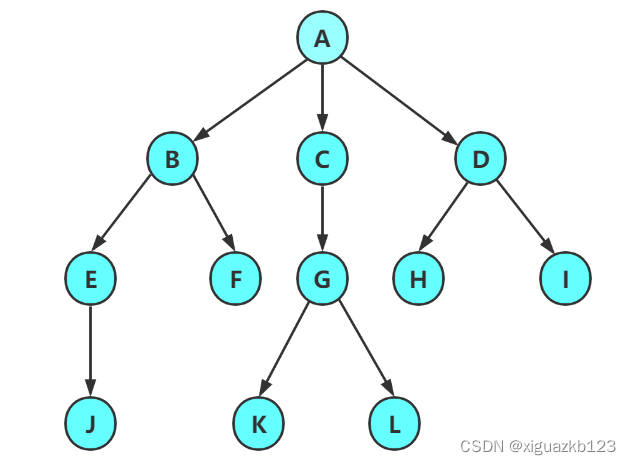
















 487
487











 被折叠的 条评论
为什么被折叠?
被折叠的 条评论
为什么被折叠?








